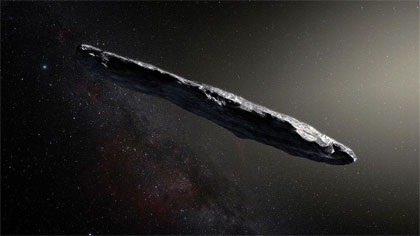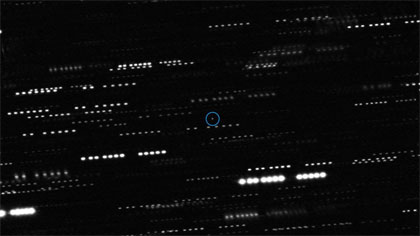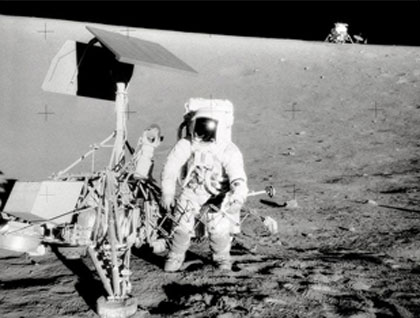
The visitors from deep space baffling scientists
 An artist’s impression of the alien object ‘Oumuamua (Credit: Alamy)
An artist’s impression of the alien object ‘Oumuamua (Credit: Alamy)
By Zaria Gorvett
6th May 2021
Astronomers spent decades looking for objects from outside our own solar system. Then two arrived at once. When should we expect the next one? And what can they teach us?
It emerged from the celestial void in October 2017 a tiny bright speck on the telescope at Haleakalā Observatory, Hawaii.
Tumbling through space at 57,000mph (90,000 kmph), the object is thought to have come from the direction of Vega, an alien star that resides 147 trillion miles (237 trillion km) away. Possibly shaped like an elongated cigar, possibly formed into an uncannily spaceship-like disc, by the time it was spotted it had already zipped by our own Sun, performed a slick hairpin turn, and begun hurtling off in another direction.
This space anomaly was named ‘Oumuamua pronounced oh-moo-uh-moo-uh Hawaiian for “a messenger from afar arriving first”. Robert Weryk, the astronomer at the University of Hawaii who first detected it, knew immediately from its speed that he was looking at something new to physics. This was no ordinary comet or asteroid, it was an interstellar visitor from a distant, unidentified solar system the first to have ever been found.
Appropriately for an object with such alien origins, it soon became clear that ‘Oumuamua was suitably strange. Two things in particular fixated scientists.
The first was its mysterious acceleration away from the Sun, which was hard to reconcile with many ideas about what it might have been made of. The second was its peculiar shape by some estimates, it was 10 times as long as it was wide. Before ‘Oumuamua, the most elongated known space objects were three times longer than they were wide.
Over the years that followed, scientific journals and global media headlines swarmed with speculation. Was it a block of solid hydrogen? Could it have been a cosmic “dust bunny” a giant space version of the clumps of hair and debris often found under living room furniture? Or was it, as the esteemed Harvard astronomer Avi Loeb suggested, an artificial construction made by an intelligent extra-terrestrial civilisation?
A surprise guest
Scientists had suspected for decades that our solar system might be regularly visited by these intergalactic voyagers, many of which are thought to have been roaming among the stars for billions of years. But though there are hundreds of specialist instruments scanning the skies each night, from a snow-battered telescope at the South Pole to the sun-baked Atacama Large Millimeter Array (Alma) in the Chilean Andes, none had ever been spotted.
Story continues below
 The brightness of ‘Oumuamua was found to fluctuate at regular intervals, suggesting that it’s rotating and either highly elongated or disc-shaped (Credit: Alamy)
The brightness of ‘Oumuamua was found to fluctuate at regular intervals, suggesting that it’s rotating and either highly elongated or disc-shaped (Credit: Alamy)
Then not long after ‘Oumuamua appeared, something unexpected happened: they found another one.
On 30 August 2019, the engineer and amateur astronomer Gennady Borisov glimpsed an object moving against the predawn sky from his personal observatory in Nauchnyi, Crimea using a telescope he had made himself. Even at first sight, he realised it was special it was travelling in a different direction to the comets that inhabit the main asteroid belt that straddles the Solar System.
2I/Borisov was named in its discoverer’s honour, and is suspected to be a rogue comet one that’s not bound to a star. So where did these visitors come from? What can they tell us about alien solar systems? And how often should we expect to see them?
To find out, first it helps to know what they are made of.
A mysterious absence
‘Oumuamua has not yet been definitively classified as a comet or an asteroid it might be something else entirely but scientists have always thought that most interstellar objects would be the former. Some of the comets that currently inhabit the furthest reaches of our own solar system may have originally been interstellar voyagers before they were captured by the Sun’s gravity, so this would make sense.
However, most comets have “tails” bright smudges that trail behind them which form when they travel close to the Sun and heat up, releasing the frozen gases and dust inside them. As you might have guessed by now, ‘Oumuamua didn’t. This was particularly jarring, because its path took it deep into the Solar System, plunging towards the Sun and missing it by a mere 0.26 AU around a quarter of the distance from the Earth to the Sun.
“As the data came in, more and more peculiarities came about,” says Loeb, adding that he attended a conference about ‘Oumuamua around this time, and when it ended, he left the room with a colleague who has worked on asteroids for decades. “He said, ‘This is so strange, I wish it had never existed’ it took people out of their comfort zone.”
You might also like:
If Planet Nine exists, why has no one seen it?
How the space race changed Soviet art
The weird space that lies outside our Solar System
At first, scientists thought that perhaps this meant ‘Oumuamua was a rocky asteroid after all. Then more observations came through. “They found that it had this acceleration as it was moving away from the Sun,” says Alan Jackson, an astronomer and planetary scientist at Arizona State University.
This was universally baffling. It’s perfectly normal for comets to accelerate as they travel back out from a close encounter with the Sun, but only because they are being powered by their tails – the gases being ejected give them a kick, like the engine on a rocket.
 ‘Oumuamua is just 400-800 meters (1,300-2,600 ft) long, and was only visible while it was near the Sun (Credit: ESO/K. Meech et al.)
‘Oumuamua is just 400-800 meters (1,300-2,600 ft) long, and was only visible while it was near the Sun (Credit: ESO/K. Meech et al.)
“That is really the straw that broke the camel’s back for me, so to speak – in addition to the Sun’s force of gravity, there was something pushing it away,” says Loeb. “In order to explain this push, you needed about a 10th of the mass of this object to evaporate.”
One idea was that perhaps the object was a “hydrogen iceberg” a giant lump of frozen hydrogen, which could have formed a tail that wouldn’t be visible from Earth.
However, not everyone was convinced. For a start, no one has ever seen hydrogen ice in space Loeb and his colleagues have argued that lumps of it couldn’t possibly have remained cold enough for long enough to form a large object like ‘Oumuamua. And given that its freezing point (-259C/-434F) is only slightly above the ambient temperature of the Universe, it seems unlikely that it would have survived the several hundred million year trek from the nearest region of space thought to make such objects. As one commentator put it, it would have fallen apart after being “cooked by starlight“.
In all the confusion, the idea that ‘Oumuamua might have been made by an intelligent alien civilisation began to look a little bit more plausible for one thing, scientists at the Seti Institute were intrigued enough to point a telescope at it and listen out for any radio signals that it might be emitting.
In the alien technology scenario, the unexplained push ‘Oumuamua received from the Sun was caused by the reflection of sunlight off its surface, which would need to be a thin, flat and reflective – like the wind pushing the sail on a boat. The object was indeed extremely shiny for how small it was, “but of course, nature doesn’t make sails”, says Loeb. “So that’s what led me to suggest in a Scientific American article and later in a scientific paper and now a book that it may be of artificial origin.”
Loeb explains that another object 2020 SO received a similarly mysterious acceleration from the Sun in September 2020. It was initially spotted by the same telescope that found ‘Oumuamua, and turned out to be a rocket booster from the failed Surveyor II mission launched in 1966, which aimed to land a spacecraft on the Moon. It was successfully launched into space, but quickly lost contact and had been drifting around for decades. Like Loeb’s proposed alien “lightsail”, it had a flat, reflective surface that could repel light and propel it forwards.
 Like the Surveyor III spacecraft, Surveyor II was intended to land on the Moon – but the latter was lost in space shortly after takeoff (Credit: Alamy)
Like the Surveyor III spacecraft, Surveyor II was intended to land on the Moon – but the latter was lost in space shortly after takeoff (Credit: Alamy)
In the end, Seti didn’t find anything though this doesn’t rule out the possibility that ‘Oumuamua belonged to a long-dead cosmic civilisation.
Then finally, earlier this year Jackson and his colleague Steven Desch came up with an explanation that seems to explain ‘Oumuamua’s quirky features, without the need for any alien technology.
They started by ruling things out. For one thing, they knew that if there were any gases leaving ‘Oumuamua, they couldn’t include carbon monoxide, water, or carbon dioxide, because astronomers would have seen them.
“It had to be something nobody had considered before,” says Desch. It also couldn’t have been hydrogen, because the Universe is just too hot. “We just realised that nitrogen ice could supply exactly the amount of push it needs and it’s observed on Pluto,” he says. To corroborate the idea, they calculated how shiny the surface of ‘Oumuamua was and compared it to the reflectivity of nitrogen ice and found that the two were more or less exact matches.
The team concluded that the object was likely to be a chunk of nitrogen ice, which was chipped off the surface of a Pluto-like exoplanet around a young star. Based on the evolution of our own solar system, which started out with thousands of similar planets in the icy neighbourhood of the Kuiper belt, they suggested that the fragment may have broken off around half a billion years ago.
“Eventually Neptune moved through that region and ejected a lot of the material – and this happened very early on,” says Desch. They suggest that ‘Oumuamua has been travelling around the frigid, barren expanse of deep space ever since.
Though the object would have finally reached the very outermost edge of the Solar System many years ago, it would have taken a long time to travel to the balmy, central region where it was first discovered and been gradually worn down into a pancake as it approached. This explains its unusual shape and its acceleration in one go, because the evaporating nitrogen would have left an invisible tail that propelled it forwards. “Our atmosphere is mostly nitrogen and you can see though it,” says Jackson. “Nitrogen gas is difficult to detect.”
Again, not everyone is happy with this suggestion.
 Pluto’s Sputnik Planitia glacier is primarily made from nitrogen ice, and contains thousands of pits suspected to be caused by floating islands of water ice (Credit: Alamy)
Pluto’s Sputnik Planitia glacier is primarily made from nitrogen ice, and contains thousands of pits suspected to be caused by floating islands of water ice (Credit: Alamy)
For one thing, Loeb is sceptical that the Pluto-like planet ‘Oumuamua came from would have had a large enough surface area for it to be statistically plausible that we have found a fragment of it.
His team have calculated that you would need for the stars in the galaxy to have have 100 times the mass they do, to account for us seeing a nitrogen iceberg that’s been chipped off. “The surface layer of Pluto is only a few percent of its size,” he says, “so that just doesn’t make sense”.
But if the theory turns out to be correct, ‘Oumuamua may have provided a rare glimpse of what lies in alien solar systems.
At the moment, we can only see the planets that orbit other stars indirectly by how much light they block out as their silhouette passes in front of the stars, or though the way their gravity distorts light as they pass by. It’s all down to the mind-boggling distances involved. Travelling the 4.2 light years (25 trillion miles) to the nearest star, Proxima Centauri, would take thousands of years with our current technology. If it left the Earth now, a spacecraft like the Voyager which is currently exploring deep space just outside our solar system would arrive in the year 75100.
“Getting to another extrasolar planet is never going to happen in my lifetime, or that of Western civilisation,” says Jackson. “But we can have nature deliver pieces of them to us that we can actually see up close.”.
The fact that ‘Oumuamua was still relatively large when it entered our solar system suggests that was still a pristine fragment of its parent planet, preserved in the icy vacuum of space for half a billion years. In all that time, it is likely to have never encountered another star up close, until it stumbled upon our own. “It probably passed through dozens of solar systems within a fraction of a lightyear, but it wouldn’t have survived another trip near a sun like ours,” says Desch.
In particular, ‘Oumuamua’s possible identity as an icy nitrogen iceberg suggests that other solar systems are reassuringly similar to our own.





















